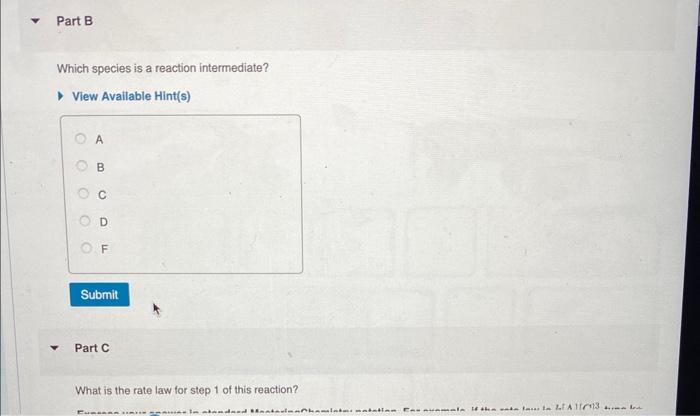Answered step by step
Verified Expert Solution
Question
1 Approved Answer
Please solve parts A,B,C,D of this question. And show steps pls! Given reaction: 1. 3A -> B + C 2. B + 2D -> C
Please solve parts A,B,C,D of this question. And show steps pls! Given reaction: 1. 3A -> B + C 2. B + 2D -> C + F 


 Order and rate law of a reaction The overall order of an elementary step directly corresponds to its molecularity. Both steps in this example are second order because they are each bimolecular. Furthermore, the rate law can be determined directly from the number of each type of molecule in an elementary step. For example, the rate law for step 1 is rate=k[NO2]2 The exponent " 2" is used because the reaction involves two NO2 molecules. The rate law for step 2 is rate=k[NO3]1[CO]1=k[NO3][CO] because the reaction involves only one molecule of each reactant the exponents are omitted. Analyzing a new reaction Consider the following elementary steps that make up the mechanism of a certain roaction: 1. 3AB+C 2. B+2DC+F Part A What ie the ningrell rearinn? What is the overall reaction? Express your answer as a chemical equation. Part B Which species is a reaction intermediate? Which species is a reaction intermediate? View Available Hint(s) A B C D F Part C What is the rate law for step 1 of this reaction? What is the rate law for step 1 of this reaction? Express your answer in standard MasteringChemistry notation. For example, if the rate law is k[A][C]3 type k* [A][C]3. View Available Hint(s) Rate = Part D What is the rate law for step 2 of this reaction? Express your answer in standard MasteringChemistry notation. For example, if the rate law is k[A][C]3 type k* [A][C]3. View Avallable Hint(s)
Order and rate law of a reaction The overall order of an elementary step directly corresponds to its molecularity. Both steps in this example are second order because they are each bimolecular. Furthermore, the rate law can be determined directly from the number of each type of molecule in an elementary step. For example, the rate law for step 1 is rate=k[NO2]2 The exponent " 2" is used because the reaction involves two NO2 molecules. The rate law for step 2 is rate=k[NO3]1[CO]1=k[NO3][CO] because the reaction involves only one molecule of each reactant the exponents are omitted. Analyzing a new reaction Consider the following elementary steps that make up the mechanism of a certain roaction: 1. 3AB+C 2. B+2DC+F Part A What ie the ningrell rearinn? What is the overall reaction? Express your answer as a chemical equation. Part B Which species is a reaction intermediate? Which species is a reaction intermediate? View Available Hint(s) A B C D F Part C What is the rate law for step 1 of this reaction? What is the rate law for step 1 of this reaction? Express your answer in standard MasteringChemistry notation. For example, if the rate law is k[A][C]3 type k* [A][C]3. View Available Hint(s) Rate = Part D What is the rate law for step 2 of this reaction? Express your answer in standard MasteringChemistry notation. For example, if the rate law is k[A][C]3 type k* [A][C]3. View Avallable Hint(s)
Please solve parts A,B,C,D of this question. And show steps pls!
Given reaction:
1. 3A -> B + C
2. B + 2D -> C + F 




Step by Step Solution
There are 3 Steps involved in it
Step: 1

Get Instant Access to Expert-Tailored Solutions
See step-by-step solutions with expert insights and AI powered tools for academic success
Step: 2

Step: 3

Ace Your Homework with AI
Get the answers you need in no time with our AI-driven, step-by-step assistance
Get Started


